News
Moves to promote local pharma industry and ensure ‘medicine security’
View(s):- Strategies and policy recommendations to follow situational analysis
facilitated by ADB and WHO on SL request
By Kumudini Hettiarachchi
Interactive and in-depth were the sessions on a matter of vital importance for Sri Lanka and its people recently – ensuring ‘medicine security’ just like ‘food security’.
The brainstorming was to develop strategies and policy recommendations to boost local pharmaceutical manufacturing and sustainability, ensuring safety, efficacy and affordability while cutting down import-dependence. With the presentation of a comprehensive ‘Situational Analysis of the Medical Products Industry in Sri Lanka’, the stakeholders from wide and varied fields including the pharmaceutical industry discussed concerns, challenges, negatives and positives.
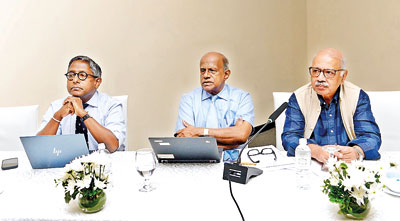
Discussion moderated by Dr. Palitha Abeykoon flanked (on his right) by Prof. Asita de Silva and Prof. Sudip Chaudhuri.
This analysis, on the request of the Sri Lankan government, has been facilitated by the Asian Development Bank (ADB) and the World Health Organization (WHO). Funded by the ADB as part of the ‘Economic Viability Study of Domestic Pharmaceutical Manufacturing in Sri Lanka’, it had been conducted by a team of consultants including Prof. Asita de Silva and Prof. Sudip Chaudhuri.
While Prof. Chaudhuri kept urging Sri Lanka not to get hobbled by viability concerns, the vision for Sri Lanka put forward by Prof. de Silva is:
- Coverage of 80% of essential drugs to be produced locally
- Good Manufacturing Practice (GMP) production of essential drugs and universal access to high quality essential medicines and other health technologies
- Development of human capital in science and technology to support the growth of the pharmaceutical sector
He explained that to achieve this vision it was essential to develop a national medicines policy & road map; strengthen the National Medicines Regulatory Authority (NMRA) & adopt a GMP Roadmap; and establish a robust quality assurance framework among several other recommendations.
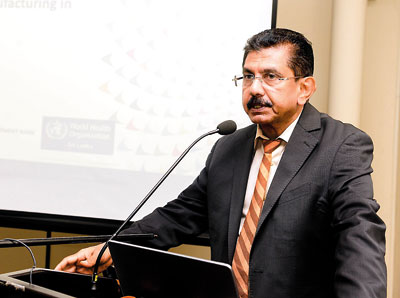
Dr. Anil Jasinghe
Looking at the pharmaceutical market in Sri Lanka, Prof. de Silva said:
- Currently around US$ 833 Mn (around Rs. 265 billion) is spent on pharmaceuticals annually. The investment on health is <3% of the GDP (Gross Domestic Product)
- Sri Lanka’s pharma supply is 85% import-dependent.
- The cost of medicines: >35% of annual health budget [18% in countries of the Organization for Economic Cooperation and Development (OECD)]
- Sri Lanka is one of the largest buyers of medicine in Asia
Next he focused on a market comparison between imported and local manufacturing, pointing out that there are 40 local manufacturing plants including those of the State Pharmaceutical Manufacturing Corporation (SPMC). (See graphic)
Focusing on the success story of Ireland, the third largest exporter of pharmaceuticals globally in 2024, Prof. de Silva, said that last year, its medical and pharma products accounted for around €80 billion in annual exports (40% of total exports).
“Ireland is now home to 19 of the top 20 multinational pharma companies, there are 120 pharmaceutical companies and 40 pharma and biopharma plants are approved by the US Food and Drug Administration (FDA). As of mid-2024, over 40,000 people were directly employed in the sector,” he said.
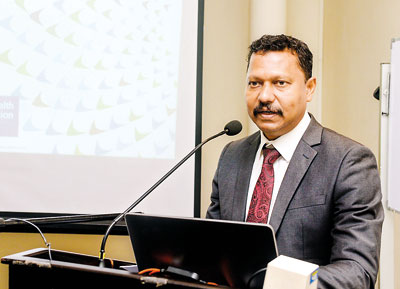
Dr. Hansaka Wijemuni
Prof. Chaudhuri pointed out that local pharma production accounts for only 15% of the pharmaceutical formulations market. The country did not manufacture vaccines and Active Pharmaceutical Ingredients (APIs). There was high accessibility and affordability of medicines but low local production share, with imports amounting to 85% of the total market.
The total market is split between government (40%) and private (60%). Of the share of 60%, local manufacturing is just 6%.
With regard to the local production structure, he said there was a “marginal” presence of only one multinational corporation (MNC) in Sri Lanka among around 20 local manufacturing firms – one public sector and the others private firms with sole/majority local ownership. The export structure was “small but rising”. In the import structure, all major MNCs and major generic firms were present in the country as suppliers.
The analysis has found that all imports of formulation products were routed through local agents, who wielded “significant” market and financial power in the import-dependent country. They have started diversifying to formulation manufacturing and these exports were rising but constitute less than 2% of the total imports.
On the evolution of government policies, Prof. Chaudhuri said that developing countries found it “very difficult” to develop their pharma industries. Among the challenges were that they could not manufacture and sell patented drugs and could not compete against MNCs in generic markets. They also had technological deficiencies and finance issues.
“In the 1950s, Sri Lanka, Bangladesh and India were import-dependent and the subsequent developments depended on what these countries did or did not do. Today, Bangladesh and India are self-reliant in formulations but not Sri Lanka. Bangladesh is import dependent on APIs and India on low valued added large volume APIs,” he pointed out.
Looking at Sri Lanka in the 1970s, he said that the drug programme was not re-structured to support local firms; product patents were not abolished; MNC activities were not regulated to create a market for local firms; and there were no import restrictions among other issues.
In more recent government policies, Prof. Chaudhuri underscored that there has been a Buy Back Agreement (BBA) with the local manufacturers since mid-2015. This has had a “huge” impact on local production without undue pressure on prices. Although there has been controversy over how the Sri Lanka Pharmaceutical Manufacturers Association (SLPMA)-BBAs and SPMC-Joint Ventures (JVs) were designed, started and implemented, the programme could be designed better and implemented.
On whether the development of the pharmaceutical industry in Sri Lanka is economically viable, he says that historically, in all countries it is economically unviable – to start with they are unable to survive and grow in the international economy without government support. Therefore, economic viability depends on both what the government does and how the local firms respond.
“Development of local production of medicines in Sri Lanka is economically viable when looking at the internationally-distinctive BBAs. These were the first major initiative by the government to support local manufacturers, with the local industry responding positively,” added Prof. Chaudhuri.
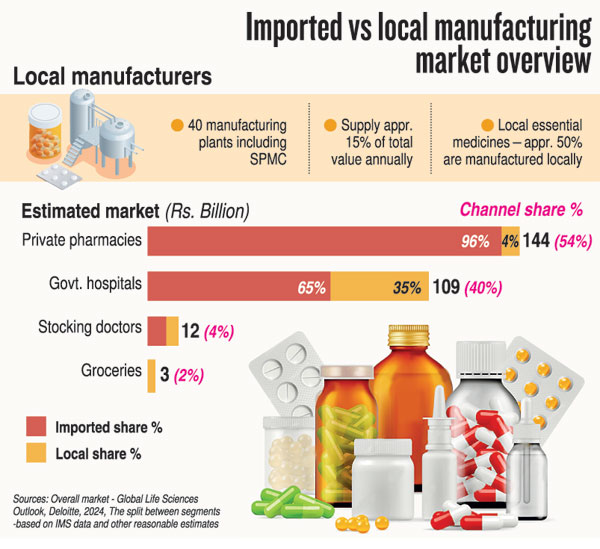
ADB’s Director of Human and Social Development Sector Office, Gi Soon Song joined the session online, while the others who addressed the inauguration included WHO Country Representative to Sri Lanka, Dr. Alaka Singh; Deputy Minister of Health Dr. Hansaka Wijemuni; and Health Secretary Dr. Anil Jasinghe.
A robust question-and-answer session on the situation analysis report as well as recommendations on possible strategies to promote local pharmaceutical production was moderated by health expert Dr. Palitha Abeykoon.
Among those present were officials from the Health Ministry, the NMRA, the State Pharmaceutical Corporation (SPC), the SPMC, the Medical Supplies Division (MSD), the Finance Ministry, the Intellectual Property Office and more.
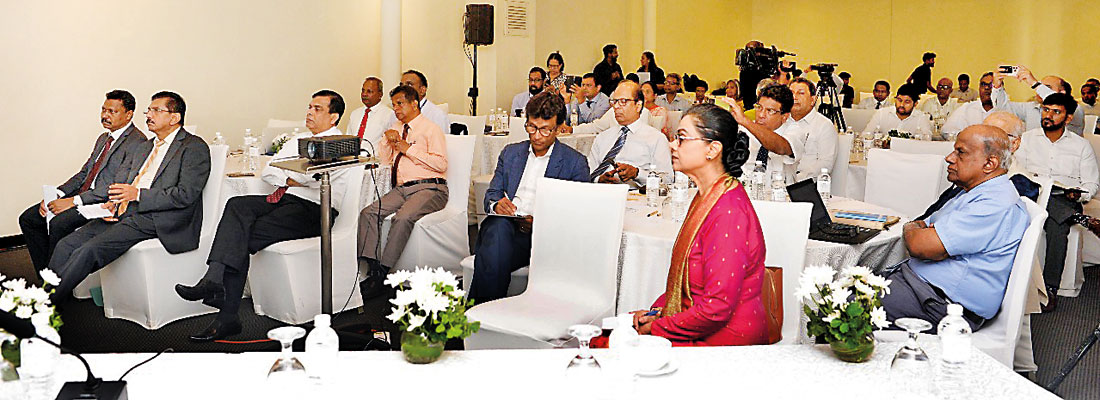
The attendees at the meeting
The best way to say that you found the home of your dreams is by finding it on Hitad.lk. We have listings for apartments for sale or rent in Sri Lanka, no matter what locale you're looking for! Whether you live in Colombo, Galle, Kandy, Matara, Jaffna and more - we've got them all!

